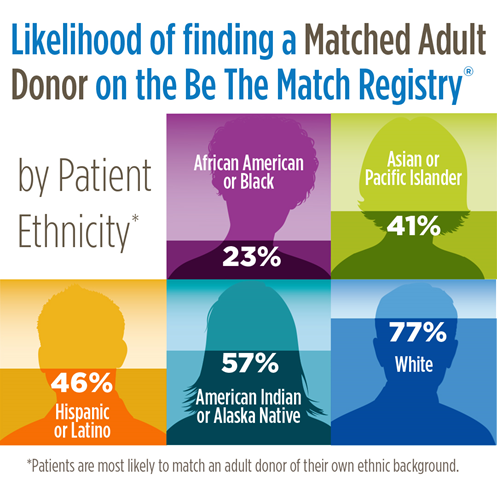
A bone marrow transplant can save the life of someone with a blood cancer such as leukemia or lymphoma. Be The Match is the national marrow registry that matches transplant donors and recipients through its registry of 22 million potential donors. Because only about 30% of patients can find a fully matched donor within their family, most people in need of a bone marrow transplant are matched through the registry.
Yet despite its large size, this volunteer registry lacks ethnic and racial diversity. This makes it harder for patients of color to get the life-saving treatments they need. For example, a Black person has a 23% chance of finding a matched donor in the registry, while a white person has a 77% chance. People who are American Indian and Alaska Native have a 57% chance of finding a registry match, Asian and Pacific Islander patients 41%, and Hispanic or Latino patients 46%. People of color make up a small percentage of all donors, making it difficult to find matches for people with cancer who are not white or who are of mixed race and ethnicity.
The registry hopes to increase its diversity by recruiting through social media and community outreach. Here’s what you need to know about why diversity is critical and what you can do to help.
What is a bone marrow or stem cell transplant?
Bone marrow is soft, spongy tissue inside your bones. It contains blood-forming cells called blood stem cells. That’s why a bone marrow transplant is also called a stem cell transplant, or more specifically, a hematopoietic stem cell transplant. Blood stem cells are powerful cells that grow into white and red blood cells and platelets. Blood stem cells also circulate in your bloodstream and in the umbilical cords of babies.
Some cancers, like leukemia, affect bone marrow and blood cells. Some people with these cancers may need a replacement or transplant of these cells from a healthy person, who is called the donor. When the replacement cells come from a donor, it is called an allogenic transplant. The goal of a transplant is to create a new immune system to destroy the cancer.
There are 3 sources of donor blood stem cells: bone marrow, circulating blood, and umbilical cord blood. In all of these cases, the healthy stem cells are infused into the vein of the person with cancer so they can grow and proliferate into healthy blood cells.
How do you find a bone marrow transplant match?
A match depends on a set of proteins on the surface of your cells called human leukocyte antigen (HLA) markers. HLA markers come in many different combinations that make them specific to you. Your body uses HLA markers to recognize your own cells and to detect and protect itself from invaders like viruses.
In a transplant, the new donor cells’ HLA markers should closely match your cells’ markers so that the donated cells don’t attack the body.
How does race and ethnicity affect a bone marrow transplant match?
You inherit HLA genes from each of your parents. These genes then code for the proteins, or markers, on your cells. Siblings are often good candidates for donors because they are more likely to have the same HLA markers as you. However, about 70% of patients needing a transplant do not have a fully matched donor in their family, and they must use a registry of unrelated donors for help.
Race and ethnicity impact HLA markers. Certain combinations of HLA markers may be common to an ethnic group because of its evolutionary history. This commonality makes matches more likely among people of the same ethnicity or race. For example, African Americans have more diverse HLA markers than other people, which makes finding a match more challenging. People who are of mixed-race descent may also have HLA markers that are relatively unique and therefore more difficult to match.
The majority of, but not all, matching donors come from the same racial or ethnic group as their recipients, says Erica Jensen, senior vice president of member engagement, enrollment, and experience at Be The Match. For example, an African American patient can find a match from someone identifying as mixed race, white, or another racial or ethnic group.
Why is diversity in the registry important?
It’s critical to have more minority donors and donors of mixed ancestry so that more matches are available to people of all backgrounds who need a transplant to survive. One of the reasons African Americans, in particular, have a more difficult time finding a match for a bone marrow transplant is that only 4% of donors in Be The Match are African American.
 “We have more and more ethnically diverse people in America, and that leads to more ethnically diverse patients. We need diversity in donors to match the diversity of the patients that we serve.” — Erica Jensen, senior vice president of member engagement, enrollment, and experience at Be The Match
“We have more and more ethnically diverse people in America, and that leads to more ethnically diverse patients. We need diversity in donors to match the diversity of the patients that we serve.” — Erica Jensen, senior vice president of member engagement, enrollment, and experience at Be The Match
How can I become a donor?
If you or someone you know is considering volunteering to become a bone marrow donor, visit Be The Match to find out more and get signed up. Donors between the ages of 18 and 44 are ideal because younger donors increase the likelihood of a transplant’s success. You can sign up online and request that a cheek swab kit be mailed to you to test your HLA markers. The Be The Match website also has information on what the donation process is like if your HLA markers match with those of a patient in need of a transplant.

Used with permission from Be The Match.
